|
Rizzan Sea-Park Hotel Tancha-Bay, staying now for the first night, is a
large hotel of 2,000 guest rooms.
I got up at 5:00. Naturally in complete darkness outside. The sunrise was
said to be 6:51, 30 minutes later than in Tokyo.
| View from the Room |
|
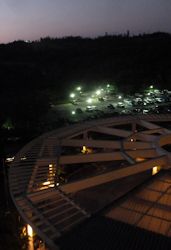 |
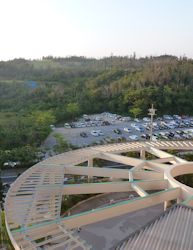 |
| 6:20 |
7:30 |
|
| In the Hotel 7:00 |
|
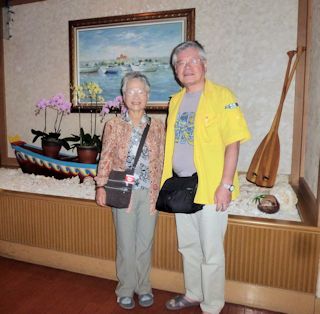 |
My breakfast was Shekwasha (flat lemon) juice, black-sesami bread, yogurt,
coffee, .....
After watching the morning drama "Massan" on NHK-BS, we went
down to the lobby.
The first sightseeing day began at 8:00, leaving the hotel in Onnason Village
along the East China Sea and heading for Gesashi Bay facing Pacific Ocean
70 km away to the north-east.
From there went up north to Cape Hedo, the northernmost of Okinawa Main
Island, and after that went directly down south to Naha City, planning
to arrive at the hotel "Okinawa Kariyushi Urban Resort" around
5:00 p.m. It was the bus drive of about 240 km.
Gesashi Bay Mangrove Forest
The Gesashi Bay mangrove is the largest of all the mangrove areas in Okinawa
covering about 10 hectares. It is a great destination to venture as three
of four types of mangrove plants can be seen here. This area was recognized
as a National Treasure by Ryukyu Kingdom in 1959, and by Japanese government
in 1972.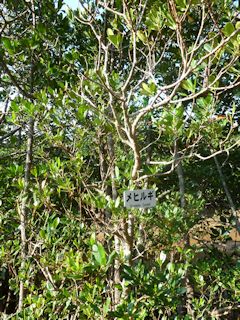
The mangrove (Hirugi) forest spreads around the mouth of Gesashi River,
about 1 km long and 200 meters wide. This is the second largest mangrove
extent in Okinawa.
The guide says, "The main trees in this mangrove forest are Himerugi.
You can see Yaeyama-hirugi along the river and Ohirugi around the upper
stream."
This scenery was not different from what I had seen somewhere else in the
south. Maybe because of it, the green forest on the sea surface fitted
well to my eyes and made me feel at ease.
It is over 20℃ now before 9:00.
We were blessed with a guide. Ms. Nakama was born and bred in Okinawa.
Her talk was humorous, fluent, easy to understand and with exquisite timing.
Not to mention the explanation of the mangrove forest, she made full use
of the bus drive. Showing the passing views, she talked about the history
of Okinawa, their climate and special culture so plainly that we did not
get bored at all.
I am going to form one part in the chapter 5, putting together her talks
in my memory.
Cape Hedo
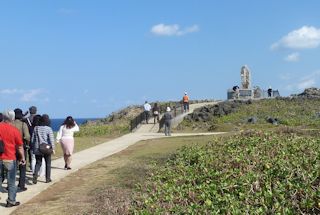
It is the northernmost place in Okinawa Main Island, facing both Pacific
Ocean and East China Sea.
We were welcomed by the Monument in Commemoration of the Reversion of Okinawa
to Japan, erected in 1972.
The land was covered by volcanic ash soil. Why is it no volcanic mountain
around nor far beyond?
"Kayauchi-banta", a sheer cliff of 100 meter height, had a rough
scenery. "Banta" is a dialect of "cliff", and it was
named after the fact that when bundled thatch was thrown away it was broken
into pieces by strong wind.
"Look! You can see it!", said the guide.
It was Yoron Island of the Amami Archipelago 22 km away.
Kouri-jima Island
Kouri-jima is said the island of the most beautiful sea. Really!
It is an isolated island with bus-crossing, north of Yagaji Island on the
north of Okinawa Main Island in the map. It is a manned island belonging
to Nakijin Village.
It is round with 3.13 square km, where elevated coral reef can be seen.
It was true. I picked up some seashells on the sand beach for my souvenir.
Ms. Nakama explained the folklore "Adam and Eve in Okinawa" as
follows.
|
In the olden times, a boy and a girl fell down from the sky to Kouri-jima
Island.
They were naked and lived a happy life eating rice cakes falling from the
heavenly sky every day.
They thought their life was natural until they came to feel worried if
the rice cakes would not fall down. Since then they left some over every
day little by little.
On the other hand, rice cakes stopped falling down when they began to save
some. They prayed and prayed to the sky in vain.
So they began to work hard by catching fishes and shells.
They saw the mating of dugong and knew the difference of a man and a woman.
After that both of them hid their front.
Their descendants increased and they became the ancestors of Ryukyu people.
|
On the way to Shuri Castle we dropped in at a 3-story store in a pineapple
field. The top was Arashiyama Observatory with a good view of the wide
sea and the bridge to Kouri-jima Island beyond.
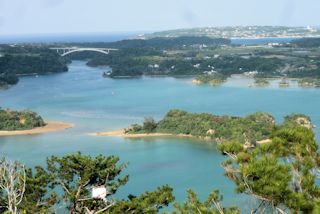
We also dropped in at "Okashi-Goten" (Cake Castle), near the obsevatory. It is a chain of the very first shop of deep red potato tart, with stores opened around Okinawa. It also had a good selection of chinsuko (Okinawan cookies).
Emiko bought some of them for souvenir. I helped her, tasting them considerably.
Shuri Castle
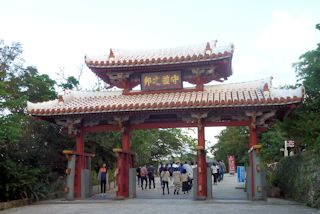
I have forgotten most of Okinawa, visited 12 years ago, and can also hardly
distinguish pictures that time, but I remember the entrance gate to Shuri
Castle. It is called Shurei Gate, with the frame showing "The Country
Respecting Manners".
The Shuri Castle Park is widened on the Shuri Hill as Shuri Castle in the
center, in the suburbs of Naha City.
We entered the park and saw the sight in and out Shuri Castle, starting
from Shurei Gate. Then, Sonohyanutaseki Gate, Kankai Gate, Zuisen Gate,
Rokoku Gate, Shichanuna Garden, and inside of Shuri Castle Main Hall.
Finally getting out of Kyukei Gate, we arrived at the bus parking area
after 10-minute walk.
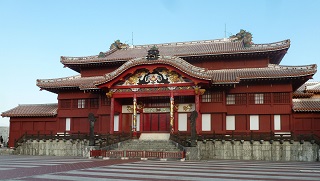 |
Seiden
(Main Hall) |
 |
Inside |
 |
Zuisen Gate |
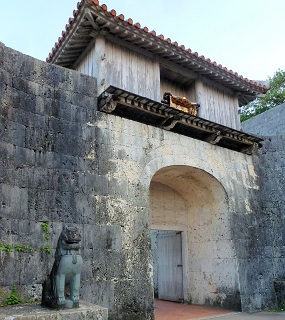 |
Kankai Gate |
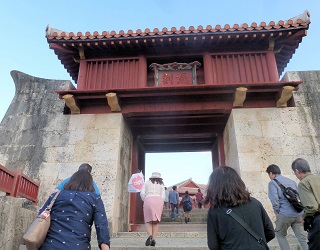 |
Rokoku Gate |
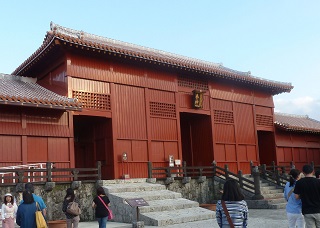 |
Kofuku Gate |
|
|
|
Shuri Castle was a king castle, built in 14th century, which reigned the
whole Okinawa area for 450 years since 1429 when the rival warlords were
unified as Ryukyu Kingdom until 1879 when Okinawa Prefecture was formed
by the Meiji Government system.
It was demolished perfectly by Okinawa Battle of Pacific War in 1945 and
the construction of Ryukyu University after that.
Its full-scale restoration was done from the end of 1980s to 1992.
In December, 2000, it was registered with cultural heritage as the eleventh
world heritage in Japan among "Gusuku Sites and Related Properties
of the Kingdom of Ryukyu". (extracted from Wikipedia)
|
Please allow me to finish this item a little in a stereotype. I feel indigested
and unsatisfied myself.
I decided to set one part "Ryukyu, Okinawa" in the chapter 5.
|